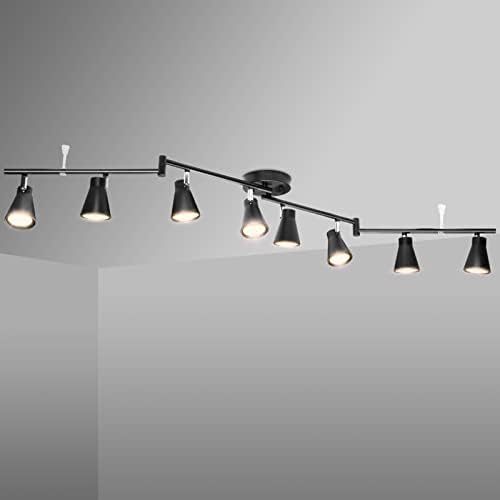Industrial track lighting systems are important for providing flexible and efficient lighting in commercial and industrial settings. They light up areas like production lines and warehouses, ensuring smooth and effective operations. Maintaining these systems is key to reducing downtime and upholding safety standards. However, they can face issues like flickering lights and overheating fixtures, which can affect their performance.
In this article, we will look into common problems with industrial track lighting and offer practical solutions. We will start by exploring the causes of flickering lights and how to fix them. Next, we will address how to achieve consistent lighting in large spaces and suggest ways to improve light distribution. We will also discuss the causes of overheating fixtures and how to prevent them. Additionally, we will cover dimming issues that can affect lighting flexibility and problems with fixture and track alignment. By understanding these problems and their solutions, facility managers can optimize their lighting systems for better performance and longevity.
Table of Contents
Flickering Lights
A common problem with industrial track lighting is flickering lights. This can be caused by things like voltage changes, incompatible bulbs, or loose connections. Voltage issues often happen because other equipment is using power from the same circuit, causing the lights to be inconsistent. Bulbs not designed for track lighting can also flicker because they don’t work well with the fixtures or dimmer switches.
Make sure all components are securely connected, as loose fittings can cause the power to cut in and out. Regularly check for any signs of wear or damage to wiring and connections. To fix these problems, use bulbs made for track lighting and ensure all connections are tight. Installing compatible dimmers can also help with flickering from mismatched settings.
Inconsistent Lighting
Getting consistent lighting in a large space can be tricky due to a few factors. One common problem is placing the light fixtures either too far apart or too close together, leading to uneven lighting with bright spots and shadows, which can be particularly noticeable in large rooms or open areas.
Using the wrong type of bulbs can make things worse, as they might not fit the fixture properly and can cause inefficient or uneven lighting. For instance, using a bulb with the wrong wattage or color temperature can affect the overall ambiance and functionality of the space. To fix these problems, it’s important to plan the lighting layout carefully. Placing fixtures evenly and using the right bulbs for the fixtures will help spread the light more evenly. Adding reflective surfaces, such as mirrors or light-colored walls, or extra light sources can also improve light distribution.
Overheating Fixtures
Overheating in track lighting fixtures can shorten their lifespan and reduce their performance. This often happens when high-wattage bulbs are used, creating too much heat. Poor ventilation around the fixtures can trap this heat, making the problem worse. To prevent overheating, always use bulbs that match the manufacturer’s recommended wattage limits and avoid placing fixtures near heat-sensitive areas.
Improving ventilation by using open fixtures, adding cooling fans, or even incorporating heat-resistant materials can help disperse heat more effectively. Regular maintenance checks can catch signs of overheating early, allowing for quick fixes. Addressing these factors helps keep your track lighting fixtures cooler, extending their lifespan and ensuring they work well.
Dimming Issues
Dimming issues in industrial track lighting can reduce the system’s flexibility and performance. These problems often come from incompatibility between the dimmer switches and the light fixtures, or from faulty components in the system. For instance, not all dimmer switches work with every type of industrial light fixture, leading to poor dimming range or flickering.
Additionally, parts like transformers or controllers might malfunction, causing erratic lighting. To fix these issues, it’s important to choose dimmer switches that are compatible with the specific fixtures you’re using. Regular maintenance checks can help find and replace faulty components before they cause bigger problems.
Fixture and Track Misalignment
Properly aligning fixtures in the track system is a must for effective lighting. Misaligned fixtures can cause uneven light, creating spots that are too bright or too dark, which reduces visual comfort and affects productivity and safety in industrial settings. Misalignment often happens due to poor installation or physical disturbances over time.
To fix this, first, inspect the entire track system to find any misaligned fixtures. Then, realign the fixtures following the manufacturer’s guidelines, ensuring they are securely attached. Use tools like a spirit level to achieve precise alignment. Regular maintenance checks help catch alignment issues early and make adjustments before they impact overall lighting performance.
Effective management of industrial track lighting systems is essential for maintaining operational efficiency and safety in commercial settings. Addressing common issues like flickering lights, inconsistent lighting, overheating fixtures, dimming problems, and misaligned fixtures can significantly enhance performance and longevity. Implementing solutions such as using compatible bulbs, ensuring proper fixture placement, improving ventilation, selecting suitable dimmers, and conducting regular maintenance can prevent disruptions and extend the lifespan of the lighting system. By prioritizing these measures, facility managers can optimize lighting conditions, ensuring a productive and well-lit environment for all industrial operations.
